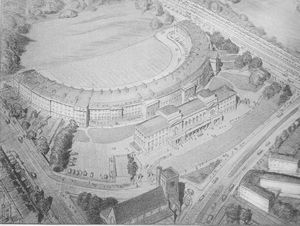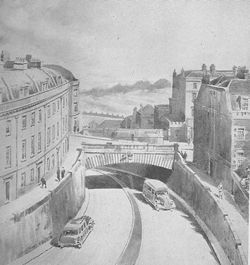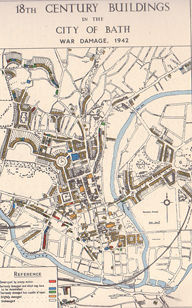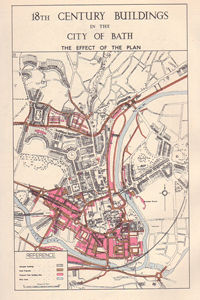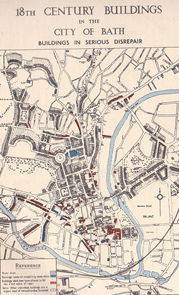|
||
|
|
||
|
Home |
General Information |
Gallery &
Reference |
History
|
News
& Events |
Community
|
Contact Us |
||
|
|
| Crescent History | Crescent Lawn History | Bath History | Literary Bath | Bath at War| What If? |
|
History What If? Those plans for Bath that thankfully never made it. Click on the bookmarks below to read some fascinating plans
A Victorian Folly and Nightmare - extracted from "Images of Bath" by James Lees-Milne, David Ford
A Victorian scheme to 'improve' the Royal Crescent: wood‑engraving, 1850
A proposed fountain in honour of Bladud: lithograph, c. 1855.
....Something has been said of the central area, especially as regards precincts protected from other than local traffic. The plan of the centre may be described as a combination of careful conservation in certain areas combined with extreme boldness in others. In the two principal precincts of old buildings into which central Bath is divided (the old Roman and medieval town, and what has been called " Wood's Town ") it is not proposed to make any marked change, although the route of the inner traffic ring will lead to some remodelling of frontages and one diagonal cut near the line of the original City walls parallel with Orchard Street ; but even here Wood's front to North Parade is preserved intact. The marked proposal made in these two precincts is one of transfer of activity and not change of building, at any rate exteriorly. This is the suggestion to move the civic offices including the Council Chamber and Mayor's Parlour from the Guildhall to the Royal Crescent. The Guildhall block with a new front to the river and Orange Grove and a fine courtyard (cleared of the retail market) would be used for central cultural purposes (library, art gallery, etc.). This, with the addition proposed to the Pump Room (which could be built without displacing for the time being the shops facing Stall Street) and the new Concert Hall, would provide Bath with sufficient expansion for its dominant activities as a Spa and town for recreation and leisure, to serve not only the region but the whole country. To change the position of the civic activities of a town must always appear as something startling; there is much to be said for a freedom from historic prejudice in a matter of this sort. Many factors change; means of locomotion diminish distance; and an old central site, suitable in the past, becomes congested. A similar move is contemplated in other towns; here the move would solve the problem of the Royal Crescent use. At the same time it may be pointed out that if this proposal is not adopted the structure of the Plan is not destroyed; both Guildhall and Royal Crescent can remain in their present use, the latter if necessary remodelled as proposed by the Society for the Protection of Ancient Buildings. In one of these schemes it is shown how a block of four typical houses could be treated as one unit, only one staircase being retained. This method of conversion somewhat. resembles the office treatment suitable for a municipal building.
This precinct contains the Guildhall block, also the properties in Bridge Street and Northgate Street up to a point nearly opposite the General Post Office entrance ; these properties are removed and replaced by an open space. Bridge Street is closed and becomes a spacious pavement between the open space and the existing Library and Art Gallery building. It is proposed to develop the Guildhall block as a cultural centre, the General Market being removed and also the other buildings abutting Grand Parade. Room is provided for the much needed extension of Library, Art Gallery and Police Station; a small hotel would complete the south cast corner and the Art School could be appropriately contained within the block. A spacious internal car park is provided and the entrance to the Old East Gate would be opened up. The development of this block is linked with our proposal to utilise a substantial portion of the Royal Crescent as a centre of civic administration. The existing accommodation at the Guildhall is inadequate and the building is situated in the centre of bustle and noise from traffic, which is often accompanied by musical trains from the gardens close by. Recent Government pronouncements have given an indication of the extended scope and responsibilities of local authorities in post War years, and adequate accommodation will have to be found. We have carefully estimated the space required for centralised office accommodation for all departments of the Corporation (except Medical Officer and Electrical Engineer) and have found that ample room would be provided by converting the central portion of the Royal Crescent (16 houses) is a first stage of this civic move; the houses completing the Crescent on either side could remain for residential purposes, either in the form of flats or private residential hotels or as private schools; a few might be adapted as offices for professional men. There would be room also in this first stage of adaptation for a certain number of committee rooms. We commend this scheme for careful consideration on the basis of properly prepared plans for the development of the site as a whole for a Centre of Civic Administration. The dilapidated Mews which fringe the sides and rear of the site do injustice to this finest creation of Wood. The sweeping away of these would provide a site for the ultimate erection of a Council Chamber and ancillary rooms as an annexe appropriately linked with the Crescent ; this would be set within spacious gardens (see Plan facing page 57 above) abutting upon the new east and west through route, but with no direct vehicular access thereto. The perspective drawing on the same page shows the proposed new building viewed from the north east. The existing front and end elevations of the Crescent would remain and the un balanced and unsightly appendages which during the process of time have been added to the rear could he replaced by properly grouped and positioned sanitary annexes as required to serve the needs of those occupying the offices. At the same time the main cornices etc. lines and fenestration of the rear elevation could be restored in such a manner as to fit in and harmonise with the buildings comprising the new Council
The spacious lawn in front of the Crescent would remain and would, when needed, be available for use on civic occasions when space is required for great public assemblies. It seems hardly necessary to draw attention to the limitations of the existing Guildhall site in this respect, and to the undesirability of perpetuating for all time the present practice of closing High Street on every civic occasion which calls for public demonstration or assembly. The Banqueting Room at the Guildhall, together with an appropriate suite of rooms, would remain for the extended social activities of the spa. The Petty Sessional Court would remain; and for the convenience of ratepayers a single office, representative of every Corporation department, would be established; at this all purpose office enquiries or complaints could be made, rates and other accounts paid, and attached to it there would be an Information Bureau where enquiries could be made as to road, rail or air travel, also spa and other activities of the City. The transfer of civic administration to the Crescent could be very conveniently accomplished in two or three stages, and the development of this great. Crescent as a Centre of Local Government would create one of the finest civic centres in the country. It would be a bold scheme calling for wisdom and great courage ....
Who needs a bypass, we can go one better - from "A Plan for Bath: Report for the Bath and District Joint Planning Committee" by Sir Patrick Abercrombie, 1945
The report details a proposed "parkway" through the city this artist impression shows what the Julian Road and Lansdown Road current intersection would have looked like. Obviously the plans were heavily intertwined with the proposed move of the Council administration to the Crescent.
Below are plans from the report which show (a) the war damage to Bath (b) the impact of the plan on the city and clearly the planned building at the back of the Crescent and the East West Parkway and (c) building deemed to be in a state of serious disrepair.
|
|
Copyright 2011 Opus 57 Ltd , All rights reserved Website developed and managed by Opus 57 Ltd |


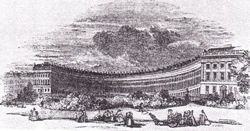
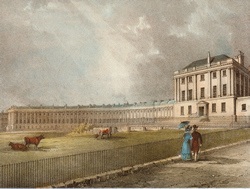
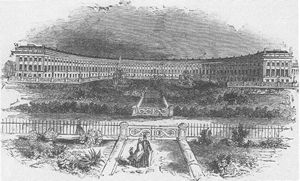
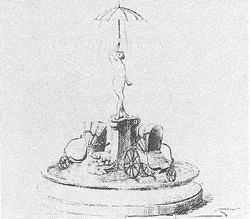 The wood engraving from the Bath and Cheltenham
Gazette of 5 June 1850 is one indication of how
the Victorians could seldom leave well alone. An
accompanying article explained that fountains
were proposed for St James's Square, Victoria
Park, the Circus, Laura Place, Queen Square and
the Royal Crescent. And not only two fountains
for the Crescent. In the forefront the Georgian
railings were to be replaced by a heavy pierced
balustrade. Niggling little shrubs and borders
were to usurp the naked expanse of lawn. A
central pathway with monstrous curbs and hideous
gates was to cut straight from the
central
house of the Crescent into infinity. Some
merciful hitch prevented this particular scheme
from eventuating. An anonymous wag, inspired by
the prevalent craze for 'improvements' on the
part of the Corporation, mooted another proposal
for the west front of the Abbey which one cannot
but regret was abandoned. The lithograph of c.
1855 was entitled 'A Rejected Design for a
Fountain'. Holding a patent German umbrella.
from which the water dripped, the nude but
bespectacled figure of the irrepressible Bladud
was made to stand on a pedestal surrounded by
two Bath chairs and his favourite sow.
The wood engraving from the Bath and Cheltenham
Gazette of 5 June 1850 is one indication of how
the Victorians could seldom leave well alone. An
accompanying article explained that fountains
were proposed for St James's Square, Victoria
Park, the Circus, Laura Place, Queen Square and
the Royal Crescent. And not only two fountains
for the Crescent. In the forefront the Georgian
railings were to be replaced by a heavy pierced
balustrade. Niggling little shrubs and borders
were to usurp the naked expanse of lawn. A
central pathway with monstrous curbs and hideous
gates was to cut straight from the
central
house of the Crescent into infinity. Some
merciful hitch prevented this particular scheme
from eventuating. An anonymous wag, inspired by
the prevalent craze for 'improvements' on the
part of the Corporation, mooted another proposal
for the west front of the Abbey which one cannot
but regret was abandoned. The lithograph of c.
1855 was entitled 'A Rejected Design for a
Fountain'. Holding a patent German umbrella.
from which the water dripped, the nude but
bespectacled figure of the irrepressible Bladud
was made to stand on a pedestal surrounded by
two Bath chairs and his favourite sow.
